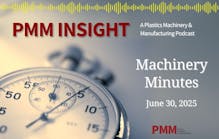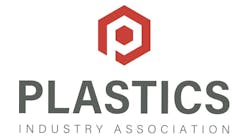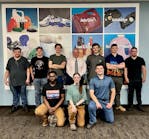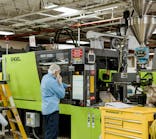Arlanxeo Deutschland GmbH, Dormagen, Germany, has patented a method and device for removing volatile compounds from polymer melts, solutions and dispersions. The devolatilization apparatus features a pre-extruder or kneader located upstream from an extruder, an extruder barrel with holes, one or more screws arranged concentrically in the barrel, at least one feed zone, and one or more devolatilization zones. The screws have treatment elements with a cross-sectional profile orthogonal to the axis of screw rotation. The device and method address the problems of overheating and prevent the resulting damage that can occur to the polymer, especially in the intermesh zones of the screw elements.
Patent 9,738,770; issued August 22
In other patent news:
Resin infusion. Boeing Co., Chicago, has invented a device for simultaneously infusing more than one type of resin into a dry fiber preform to make composite parts. The device consists of multiple resin-delivery assemblies and flow media that overlap. Each resin-delivery assembly includes a spiral resin-delivery tube. The system uses a vacuum to deliver the resin.Sometimes, composite parts may need "two different resin systems for appearance or for a functional purpose such as anti-abrasion, anti-reflection or impact resistance," the patent states. However, to achieve that, conventional methods involve applying a second resin after the part has been fabricated, or applying a gel coat in a resin infusion tool in a separate step. Those methods can result in surface layers that can chip or delaminate from the substrate.The new invention saves time and labor by producing parts from two resins in a single process, the patent says. "The mechanical performance and appearance of resin-infused parts may also be improved using the disclosed method and apparatus." Patent 9,738,011; issued Aug. 22
Vent assembly. Japan Steel Works Ltd., Tokyo, has patented a vent assembly for a twin-screw extruder that can be modified easily to adapt to the differences in viscosity, flowability and degree of adhesion of various resins, as well as the volatile substances they generate. The shape of the modular system can be changed easily, eliminating the need to create an entirely new vent assembly when processing different materials. This also makes maintenance less expensive, since only damaged modules need to be replaced, instead of the entire device. "Problems such as vent rise, vent wall adhesion, scattering of resin fragments (entrainment) and the like … can be forestalled by using the vent assembly," the patent states. Patent 9,731,448; issued Aug. 15
Injection molding. Fanuc Corp., Yamanashi, Japan, received a patent for a press that has multiple injection units for sequential injection molding. The injection molding machine also has a module that acquires data from the injection devices and a cycle counter. The technology overcomes the difficulties in counting molding cycles when multiple injection units are used for sequential molding. According to the patent, the technology allows the machine operator to more easily understand the relationship between the operational data for the injection devices and the number of parts made. The invention also includes a data display unit that shows the mold cycle count and data for each injection unit, such as changes in molding conditions. Patent 9,701,054; issued July 11
Injection molding. Nissei Plastic Industrial Co. Ltd., Nagano, Japan, has applied for a patent for a molding machine with a mold-clamping apparatus and controller that compensate for deflection of the mold, solidification of the resin in the mold and the natural compression of the resin due to elastic recovery of the mold. The patent application says it provides "the optimal natural compression to the resin." Other advantages include high-quality, consistent production and "simpler molding conditions and easier setting," as well as simplified quality control and shorter molding cycles.In a preferred embodiment of the patent, the machine has a noncontact distance-measurement sensor with a projection section on the outer face of the fixed mold and a reflecting section on the outer face of the movable mold. Each of the molds has supports to maintain proper mold-gap status. "This configuration can directly detect the shape change of the parting gap between the fixed mold and the movable mold, i.e., the deflection of the mold due to the elastic deformation in an easy and accurate manner," the patent states. Patent application 20170282423; published Oct. 5
Welding. Branson Ultraschall Niederlassung der Emerson Technologies GmbH & Co. OHG has proposed an infrared welder for joining plastic components.In an application for a patent, the Dietzenbach, Germany, company said the welder has at least one radiation source, a control with at least one frequency converter and an assembly for holding and moving components to be welded. While frequency converters on other welders supply three distinct outputs of energy, Branson's welder has a frequency converter that supplies only two. The converter can drive several heat radiators; using multiple heat radiators lowers the amount of electrical voltage any of the radiators requires and reduces risks to workers. To simplify the device, Branson proposes running multiple radiators off shared current supplies; this contrasts with other welders, which have separate power supplies for each radiator. Patent application 20170305130; published Oct. 26
Compounding/extrusion screw. Reifenhäuser GmbH & Co. KG Maschinenfabrik, Troisdorf, Germany has designed a new extrusion screw that features mixing channel wall surfaces oriented at right angles to its wiping and barrier lands to achieve better extrudate mixing. The screw promotes mixing because the layout forces a portion of extrudate to change direction upon hitting the inside wall surfaces of the mixing channels. Patent 9,764,496; issued Sept. 19








